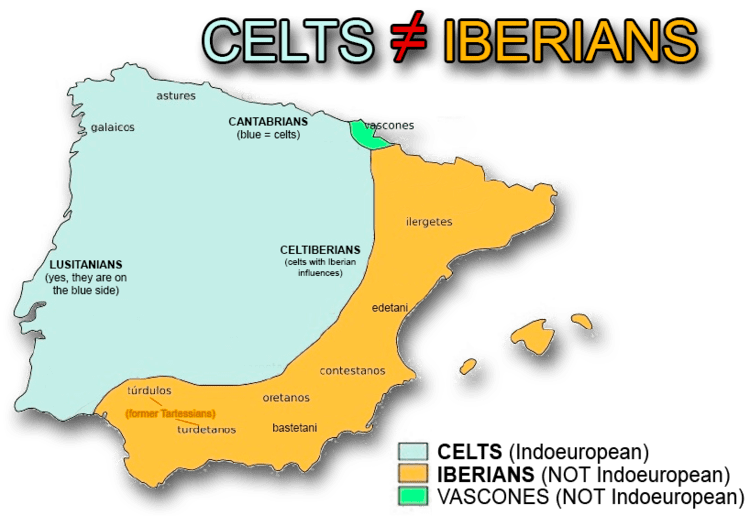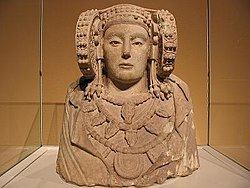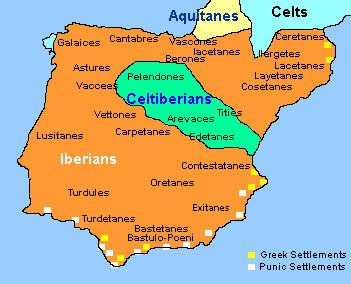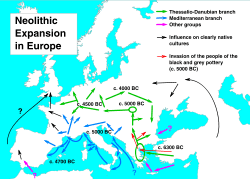 | ||
Iberians
The Iberians (Latin: Hibērī, from Greek: Ίβηρες) were a set of peoples that Greek and Roman sources (among others, Hecataeus of Miletus, Avienus, Herodotus and Strabo) identified with that name in the eastern and southern coasts of the Iberian peninsula, at least from the 6th century BC. The Roman sources also use the term Hispani to refer to the Iberians.
Contents
- Iberians
- History
- Settlements
- Second Punic War and Roman conquest
- Iberian culture
- Art and religion
- Warfare
- Iberian tribes
- Iberian language
- Iberian scripts
- References

The term Iberian, as used by the ancient authors, had two distinct meanings. One, more general, referred to all the populations of the Iberian peninsula without regard to ethnic differences (Pre-Indo-European, Celts and non-Celtic Indo-Europeans, such as the Lusitanians). The other, more restricted ethnic sense, refers to the people living in the eastern and southern coasts of the Iberian peninsula, which by the 6th century BC had absorbed cultural influences from the Phoenicians and the Greeks. This non-Indo-European cultural group spoke the Iberian language from the 7th to the 1st century BC.

Other peoples possibly related to the Iberians are the Vascones, though more related to the Aquitani than to the Iberians. The rest of the peninsula, in the northern, central, northwestern, western and southwestern areas, was inhabited by Celts or Celtiberians groups and the possibly Pre-Celtic Indo-European Lusitanians, Vettones, and the Turdetani.

History

The Iberian culture developed from the 6th century BC, and perhaps as early as the fifth to the third millennium BC in the eastern and southern coasts of the Iberian peninsula. The Iberians lived in villages and oppida (fortified settlements) and their communities were based on a tribal organization. The Iberians in the Spanish Levant, were more urbanized than their neighbors in the central and northwestern regions of the Iberian peninsula. The peoples in the central and northwest regions were mostly Celtic, semi-pastoral and lived in scattered villages, though they also had a few fortified towns like Numantia. They had a knowledge of writing, metalworking, including bronze, and agricultural techniques.
Settlements
In the centuries preceding Carthaginian and Roman conquest, Iberian settlements grew in social complexity, exhibiting evidence of social stratification and urbanization. This process was probably aided by trading contacts with the Phoenicians, Greeks, and Carthaginians.
The settlement of Castellet de Banyoles in Tivissa was one of the most important ancient Iberian settlements in Catalonia that was discovered in 1912. Also, the 'Treasure of Tivissa', a unique collection of silver Iberian votive offerings was found here in 1927.
Lucentum was another ancient Iberian settlement, as well as Castelldefels Castle.
Mausoleum of Pozo Moro near the town of Chinchilla de Monte-Aragón in Castile-La Mancha seems to mark the location of another big settlement.
Sagunto is the location of an ancient Iberian and later Roman city of Saguntum, where a big fortress was built in the 5th century BC.
Greek colonists made the first historical reference to the Iberians in the 6th century BC. They defined Iberians as non-Celtic peoples south of the Ebro river (Iber). The Greeks also dubbed as "Iberians" another people in the Caucasus region, currently known as Caucasian Iberians. It is not known if there had been any type of connection between the two peoples.
The Iberians traded extensively with other Mediterranean cultures. Iberian pottery and metalwork has been found in France, Italy, and North Africa. The Iberians had extensive contact with Greek colonists in the Spanish colonies of Emporion, Rhode, Zakynthos and Hemeroskopeion. The Iberians may have adopted some of the Greeks' artistic techniques. Statues such as the Lady of Baza and the Lady of Elx are thought to have been made by Iberians relatively well acquainted with Greek art. Thucydides stated that one of the three original tribes of Sicily, the Sicani, were of Iberian origin, though "Iberian" at the time could have included what we think of as Gaul.
The Iberians also had contacts with the Phoenicians, who had established various colonies in southern Andalucia. Their first colony on the Iberian Peninsula was founded in 1100 BC and was originally called Gadir, later renamed by the Romans as Gades (modern Cádiz). Other Phoenician colonies in southern Iberia included Malaka (Málaga), Sexi and Abdera.
Second Punic War and Roman conquest
After the First Punic war, the massive war debt suffered by Carthage led them to attempt to expand their control over the Iberian peninsula. Hamilcar Barca began this conquest from his base at Cádiz by conquering the Tartessian Guadalquivir river region, which was rich in silver. After Hamilcar's death, his son Hasdrubal continued his incursions into Iberia, founding the colony of Qart Hadasht (modern Cartagena) and extending his influence all the way to the southern bank of the river Ebro. After Hasdrubal's assassination in 221 BC, Hannibal assumed command of the Carthaginian forces and spent two years completing the conquest of the Iberians south of the Ebro. In his first campaign, Hannibal defeated the Olcades, the Vaccaei and the Carpetani expanding his control over the river Tagus region. Hannibal then laid siege to Roman ally of Saguntum and this led to the beginning of the Second Punic War. The Iberian theater was a key battleground during this war and many Iberian and Celtiberian warriors fought for both Rome and Carthage, though most tribes sided with Carthage.
Rome sent Gnaeus and Publius Cornelius Scipio to conquer Iberia from Carthage. Gnaeus subsequently defeated the Iberian Ilergetes tribe north of the Ebro who were allied with Carthage, conquered the Iberian oppidum of Tarraco and defeated the Carthaginian fleet. After the arrival of Publius Scipio, Tarraco was fortified and, by 211 BC, the Scipio brothers had overrun the Carthaginian and allied forces south of the Ebro. However, during this campaign, Publius Scipio was killed in battle and Gnaeus died in the retreat. The tide turned with the arrival of Publius Cornelius Scipio Africanus in 210 BC. Scipio attacked and conquered Carthago Nova and defeated the army of Hasdrubal Barca at the Battle of Baecula (209-208). The war dragged on with Carthage sending more reinforcements until the Battle of Ilipa (modern Alcalá del Río in Sevilla province), which was a decisive victory for Publius Scipio Africanus. The Carthaginians retreated to Gades, and Publius Scipio gained control over the entire south of the peninsula. After this victory, the Ilergetes and other Iberian tribes revolted and it was only after this revolt that the Romans conquered the rest of the Carthaginian territories in southern Spain.
After the Carthaginian defeat, the Iberian territories were divided into two major provinces, Hispania Ulterior and Hispania Citerior. In 197 BC, the Iberian tribes revolted once again in the H. Citerior province. After securing these regions, Rome invaded and conquered Lusitania and Celtiberia. The Romans fought a long and drawn out campaign for the conquest of Lusitania. Wars and campaigns in the northern regions of the Iberian peninsula would continue until 16 BC, when the final rebellions of the Cantabrian Wars were defeated.
Iberian culture
Iberian society was divided into different classes, including kings or chieftains (Latin: "regulus"), nobles, priests, artisans and slaves. Iberian aristocracy, often called a "senate" by the ancient sources, met in a council of nobles. Kings or chieftains would maintain their forces through a system of obligation or vassalage that the Romans termed "fides".
While the culture in the east coast was influenced by Greeks and Phoenicians from the 7th century BC, the Iberians in the area of Aragon and Castille intermixed with the Celtic Hallstatt culture and hence are termed Celtiberians. The Iberians adopted wine and olives from the Greeks. Horse breeding was particularly important to the Iberians and their nobility. Mining was also very important for their economy, especially the silver mines near Gader and Cartago Nova, the iron mines in the Ebro valley, as well as the exploitation of tin and copper deposits. They produced fine metalwork and high quality iron weapons such as the falcata.
Art and religion
The Iberians produced sculpture in stone and bronze, most of which was much influenced by the Greeks and Phoenicians, and other cultures such as Assyrian, Hittite and Egyptian influences. The styles of Iberian sculpture are divided geographically into Levantine, Central, Southern, and Western groups, of which the Levantine group displays the most Greek influence. Iberian pottery and painting was also distinct and widespread throughout the region.
The Iberian polytheistic religion was influenced by the Greek and Phoenician practices, as it is evident in their sculptures. The man-bull Bicha of Balazote (possibly a fertility deity) and various depictions of sphinxes and lions bear a resemblance to eastern Mediterranean mythological creatures. The Lady of Elche and Lady of Guardamar show clear Hellenistic influence. Phoenician and Greek deities like Tanit, Baal, Melkart, Artemis, Demeter and Asclepius were known in the region and worshiped. Currently few native Iberian gods are known, though the oracular healing deity "Betatun" is known from a Latin inscription at Fuertes del Rey. There was clearly an important female deity associated with the earth and regeneration as depicted by the Lady of Baza and linked with birds, flowers and wheat. The horse was also an important religious figure and an important sanctuary dedicated to Horses has been found in Mula (Murcia). There are many depictions of a "horse taming god" or "lord of the horses" (despotes hippon). The female goddess Ataegina is also widely attested in the inscriptions.
Iberians performed their rites in the open and also maintained sanctuaries in holy places like groves, springs and caves. Archaeological evidence suggests the existence of a priestly class and Silius Italicus mentions priests in the region of Tartessos at a temple of Melqart. Evidence from pottery reveals some information about Iberian myth and ritual. Common themes are a celebratory ritual dance described by Strabo [c.f. 3.3.7.] and seen in a relief from Fuerte del Rey known as the "Bastetania dance" and the confrontation between the deceased and a wolf figure. Ritual sacrifice of animals was also common.
The Iberians incinerated their dead and placed their ashes in ceremonial urns, the remains were then placed in stone tombs.
Iberians venerated the war god Cariociecus.
Warfare
Iberian warriors were widely employed by Carthage and Rome as mercenaries and auxiliary troops. A large portion of Carthaginian forces during the Punic wars was made up of Iberians and Celtiberians. Iberian warfare was endemic and based on intertribal raiding and pillaging. In set piece battle, Iberians were known to regularly charge and retreat, throwing javelins and shouting at their opponents without actually committing to full contact combat. This sort of fighting was termed concursare by the Romans. The Iberians were particularly fond of ambushes and guerrilla tactics.
Ancient sources mention two major types of Iberian infantry, scutati and caetrati. Scutati were heavily armored and carried large Celtic type scutum shield. The caetrati carried the caetra, a small Iberian buckler. Iberian armaments included the famed Gladius Hispaniensis, a curved sword called the falcata, straight swords, spears, javelins and an all iron spear called the Soliferrum. Iberian horsemen were a key element of Iberian forces as well as Carthaginian armies. Spain was rich with excellent wild horses and Iberian cavalry was some of the best in the ancient Mediterranean.
Iberian tribes
Iberians dwelt along eastern and southern coastal regions of the Iberian Peninsula, that corresponds to the northwestern shores of the Mediterranean Sea (see the map), roughly in today's Catalonia, Eastern, Northeastern and Northern Aragon, Valencian Community, Murcia Region, Eastern Andalucia, and the Balearic Islands (in Spain), and also in today's Roussillon and parts of Languedoc (in France). The peninsula has this name because ancient Greeks, Romans and other mediterranean peoples first contacted with peoples (tribes or tribal confederacies) that were Iberians in the ethnic and linguistic sense, although the majority of the Iberian Peninsula's peoples, that dwelt in the Northern, Central and Western regions (the majority of the peninsula's area), were not Iberians themselves in the ethnic and linguistic sense (they could only be considered Iberians in the geographical sense, i.e. they dwelt in the Iberian Peninsula).
The Iberian tribes or tribal confederacies were:
Iberian language
The Iberian language, like the rest of the paleohispanic languages, became extinct by the 1st to 2nd centuries AD, after being gradually replaced by Latin. The Iberian language remains an unclassified non-Indo European language. A 1978 study claimed many similarities between Iberian and the Messapic language. Iberian languages also share some elements with the Basque language. Links have also been found with the Etruscan language and Minoan Linear A.
Iberian scripts
The Iberians use three different scripts to represent the Iberian language.
Northeastern Iberian script and southeastern Iberian script share a common distinctive typological characteristic, also present in other paleohispanic scripts: they present signs with syllabic value for the occlusives and signs with monofonematic value for the rest of consonants and vowels. From a writing systems point of view, they are neither alphabets nor syllabaries, they are mixed scripts that normally are identified as semi-syllabaries. About this common origin, there is no agreement between researchers: for some this origin is only linked to the Phoenician alphabet while for others the Greek alphabet had participated too.
